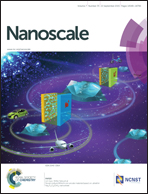A highly sensitive, low-cost, wearable pressure sensor based on conductive hydrogel spheres†
Abstract
Wearable pressure sensing solutions have promising future for practical applications in health monitoring and human/machine interfaces. Here, a highly sensitive, low-cost, wearable pressure sensor based on conductive single-walled carbon nanotube (SWCNT)/alginate hydrogel spheres is reported. Conductive and piezoresistive spheres are embedded between conductive electrodes (indium tin oxide-coated polyethylene terephthalate films) and subjected to environmental pressure. The detection mechanism is based on the piezoresistivity of the SWCNT/alginate conductive spheres and on the sphere–electrode contact. Step-by-step, we optimized the design parameters to maximize the sensitivity of the sensor. The optimized hydrogel sensor exhibited a satisfactory sensitivity (0.176 ΔR/R0/kPa−1) and a low detectable limit (10 Pa). Moreover, a brief response time (a few milliseconds) and successful repeatability were also demonstrated. Finally, the efficiency of this strategy was verified through a series of practical tests such as monitoring human wrist pulse, detecting throat muscle motion or identifying the location and the distribution of an external pressure using an array sensor (4 × 4).


 Please wait while we load your content...
Please wait while we load your content...